Best of India Tours
- Golden Triangle Tour- Best of India & Nepal
- Classical Rajasthan
India Cultural Tours
- Images of North India- Karnataka Heritage
- Rajasthan & Goa Tour
Discover India Tours
- Grand India Tour- North to South India
- Central to South India
Rajasthan Tours
- Classical Rajasthan Tour- Golden Triangle Tour
- Grand Mughal Tour
India Luxury Trains
- Palace on Wheels- The Golden Chariot
- India Deccan Odyssey
- The Indian Maharaja
- Royal Rajasthan on Wheels
Nepal Tours
- Glimpses of Nepal- Buddhist Pilgrimage
- Nepal River Rafting
- Destinations of Nepal
- Nepal General Info
India Wildlife Tours
- North India Wild Life- South India Wildlife
Tibet Tours
- Tibet Monastery Tours- Explore Tibet
- Destinations of Tibet
Spa & Yoga Tours
- Ananda in Himalayas- Yoga & Meditation
Adventure Tours
- Manali Safari Tour- Himalayan Trekking
- Horse Safari
Ajanta
Ajanta
![]() Aurangabad
Aurangabad
![]() Lonavala
Lonavala
![]() Mahabaleshwar
Mahabaleshwar
![]() Mumbai
Mumbai
![]() Pune
Pune
![]() Shirdi & Shani Shingnapur
Shirdi & Shani Shingnapur
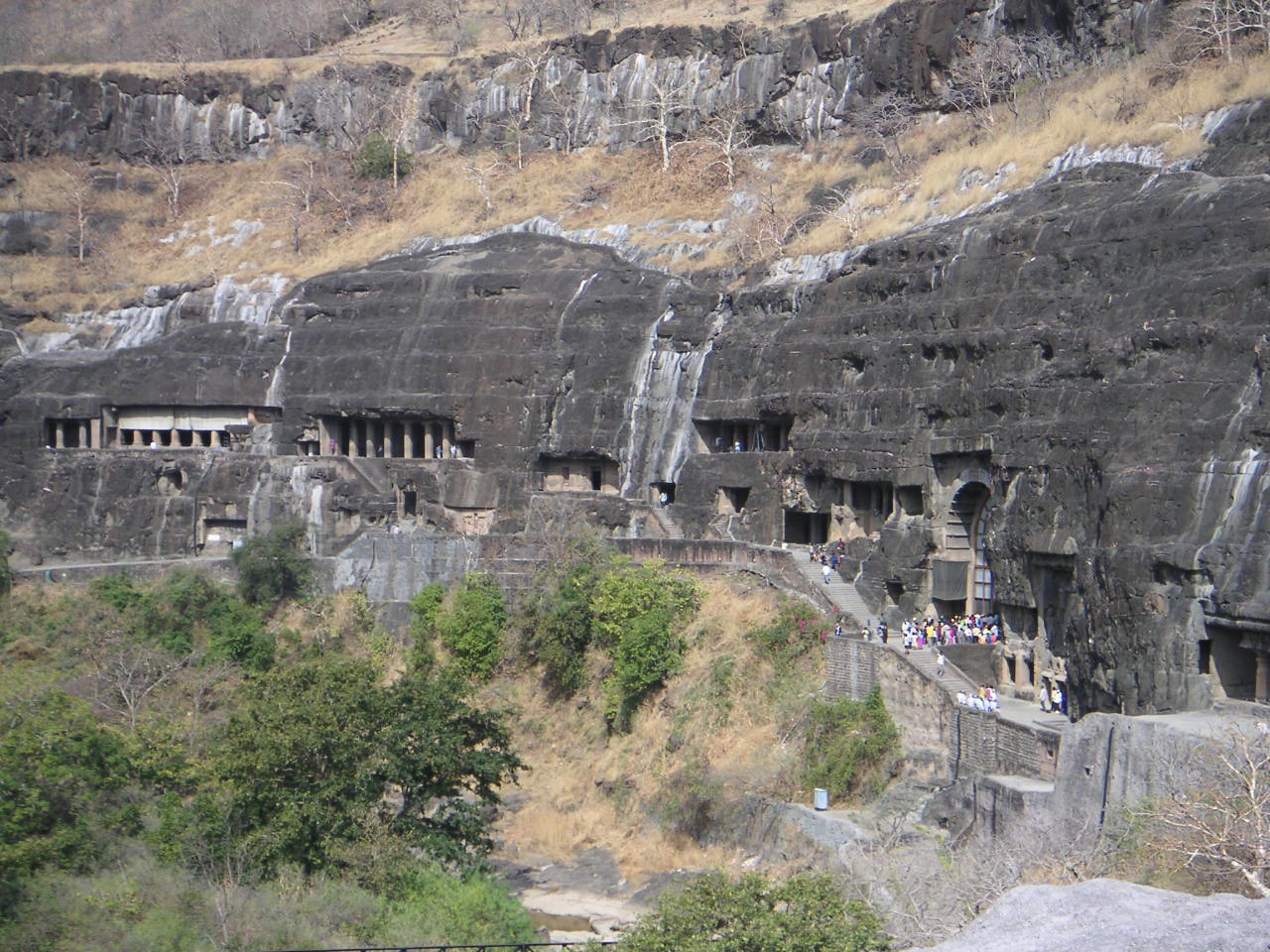
Aurangabad, the city named after the Mughal emperor Aurangzeb, is more than just simply a place to stay while visiting famous cave temples of Ajanta and Ellora. Places to see in the city include Bibi-Ka-Maqbara, the only example of Moghul architecture in the Deccan Plateau; Aurangabad caves, built in the 6th or 7th century; History Museum, Panchakki. The Ajanta and Ellora caves, about 30 kms from the city, are famous for their paintings and sculptures and the earliest caves date around 200 B.C. Unlike the Ellora caves, which are Buddhist, Hindu and Jain, the Ajanta caves are all Buddhist.
AJANTA CAVES -
ELLORA CAVES -
KANHERI CAVES -
JUNNAR CAVES -
BHAJA CAVES -
KARLA CAVES
Ajanta Caves
The Ajanta caves consist of 30 Caves including the unfinished ones, dating back from 200 BC to 250 AD. These caves are situated 104 kms from Aurangabad and 52 kms fromJalgaon Railway Station. The caves are cut from the volcaniclava of the Deccan in the forest ravines of the Sahyadri Hills and are set in beautiful sylvan surroundings. They were discovered accidentally by a British Captain, John Smith in 1819, while on a hunting expedition.

Ajanta provides a unique combination of architecture, sculpture and paintings. Two basic types of monasticBuddhist architecture are preserved at Ajanta, the Chaitya or prayer hall (Cave Nos. 9,10,19,26 & 29) and Vihara or monastery (remaining 25 Caves). These caves suggest a well defined form of architecture, broadly resolving into two phases with a time gap of about 4 Centuries from each other. In the Hinayana Phase are included two Chaitya Halls (Cave Nos. 9&10) and 4Viharas (Cave Nos. 8, 12, 13 & I5A). In the MahayanaPhase are included 3 Chaityas (Cave nos. 19 & 26 and 29being incomplete) and 11 exquisite Viharas (Cave Nos. 1,2,4,6,7,11,15,17 and 20 to 24).
The Ajanta sculptures of the Mahayana Phase establish a formal religious imagery. While the Hinayana monuments at the site are virtually devoid of carvings. Cave I, is one of the finest monasteries and the interior paintings here, are among the greatest at Ajanta. Graciously posed Bodhisattvas namely Padmapani and Vajrapani with elaborate head dresses flank the antechamber doorway. The walls on the side of the antechamber depict the assault and temptation by Mara and the miracle at Sravasti. Scenes from the Jataka tales such as Shibi Jataka, Samkhpala Jataka, Mahajanka Jataka, and Champeyya Jataka are depicted in the walls of the cave.
Cave 2, monastery repeats the basic scheme of Cave I, and is also remarkable for its painted ceiling. The paintings include, variety of designs, scrollwork, geometric patterns, miniature seated Buddhas, dream of the Buddha's mother, Maya and the birth of the Buddha, procession of female devotees carrying offerings and scenes from the Harnsa Jataka and Vidhurapandita Jataka. Caves 4 & 6 are Viharas or Monasteries of architectural interest. Cave 9, 10, 12 & I5A, are Chaitya Halls of the Hinayana period. Cave 10 is among the first excavations at the site and is one of the most impressiveearly Buddhist Chaitya Halls in Western India dating back to the2nd Century BC. This cave contains both the earlier and later groups of paintings. Scenes from the Sama Jataka and Chhaddanta Jataka are depicted. Cave 12 has lost its facade, with the result that the interior square hall is now exposed. In cave 15A onlyportions of the front wall survive.
Cave 14, 15 & 16, are Viharas belonging to the Mahayana Phase. Cave 14 was planned on a large scale, but was never finished. The verandah of cave 15 has mostly fallen. Above the doorway is a stupa sheltered by a canopy of serpent hoods. Buddha images appear in the shrine and on the rear wall of the hall. Cave 16 is one of thefinest monasteries at Ajanta. Within the hall on the left wallis an illustration of the conversion of Nanda, Buddha's cousin. Other paintings include the miracle of Sravasti, elephant procession, Buddha begging for alms from his wife and son, Gautam's first meditation, scenes from the Hasti Jataka and Maha Ummagga Jataka.
Cave 17, a vihara preserves the greatest number of wall-paintings which includes a row of eight Buddhas, a much damaged panel of Indra flying through the clouds accompanied by his troupe of celestial dancers, Apsaras and Musicians, Buddha subduing Nalagiri, the furious elephant sent by his jealous cousin, Devadatta and scenes from various Jataka tales such as the Chhaddanta Jataka, Mahamapi Jataka, Vessantara Jataka, SutasomaJataka, Matiposaka Jataka, Sama Jataka, Ruru Jataka and Nigrodhamriga Jataka. Cave 19, is a perfectly executed rock-cut Chaitya. Cave 20 is a small monastery in which the antechamber protrudes into thehall and there are no columns. Caves 21 to 24 represent the last examples of work at Ajanta. They are all in different stages of completion. Cave 26 is a Chaitya Hall larger than of Cave 19, but is otherwise similar in its arrangement and decorative scheme.
Ellora Caves
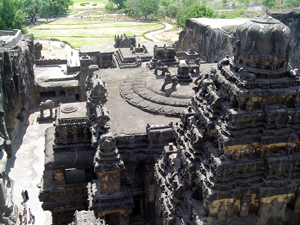
Carved in the volcanic rocks at Ellora, the Hindu, Jain and Buddhist caves are amongst the finest in the country. Total of 34 caves, 12 Buddhist caves were created between VII and IX centuries include monasteries and chapels where the monks worshipped having various stone cut structures and images of Buddha. 17 Hindus caves created during VII and X centuries have images of various Gods and Goddesses, the Kailash Temple is the most magnificent rock-cut structures meant to be a replica of Siva's celestial abode - Kailash. The 5 Jain caves which were created between IX and XII century have an aura peace and simplicity, the carvings depict Mahavir and various animals.
Kanheri Caves
Situated 42 kms north of Mumbai, near Borivili, the Kanheri Caves were once protected by a dense jungle. The Caves are set in the heart of the Borivili National Park. There are 109 Caves dating from 1st Century BC to 9th Century AD, each connected with a flight of steps. The most important one is the Cave No.3 of the 6th Century which has the last of the excavated Chaitya Hall of the Hinayana Order. It has 34 pillars and is like a colonnaded hall 28 mtrs.xl3 mtr. in dimension. These encircle a 5 mtrs. high Dagoba or Stupa and have carvings depicting elephants kneeling and worshipping the Stupa. The other important caves are.
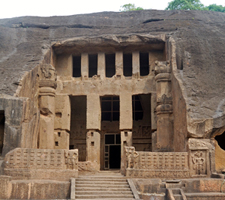
Cave 11, the Durbar Hall or the Assembly hall with a statue of the Buddha occupying the central place as in the case of idols in Hindu temples and also a number of cells for Buddhist monks. Cave 34 is a dark cell and has paintings of the Buddha on the ceiling. Cave 41 has, besides other sculptures, a figure of the eleven headed Avalokiteshvara. Cave 67 is a big cell, with the figure of Avalokiteswara as saviour flanked by two female figures in the verandah. There are also images of the Buddha depicting the miracle of Sravasti.
Junnar Caves
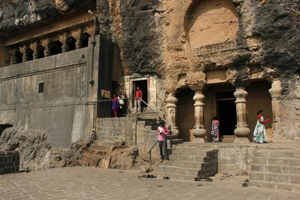
Junnar, the birth place of the Maratha chieftain Chhatrapati Shivaji, is 177 kms from Mumbai on the Mumbai-Aurangabad route. The hills surrounding the plains of Junnar are honeycombed with a clusterof Buddhist caves, which are divided into three distinct groups. These caves belongs to the period 2nd Century BC to 3rd Century AD. 5 kms to the west are the Tulija Lena Group which has a circular dome ceiling in the Chaitya Hall (Cave No. 3.). The second group of caves are located 1.5 kms south of the town, towards the Manmodi Hills. It has a well preserved facade. The third group, Ganesh Lena Group is located 4 kms south of Junnar. There are a large number of small cells and viharas in the group, the principal being the Chaitya Cave No. 6 and the vihara now known as the Ganesh Lena.
Bhaja Caves
Bhaja has 18 caves belonging to the 2nd Century BC. Cave No. 12 is the largest and has a fine stilted vault. The last cave to the south has excellent sculptures including that of the famous 'Dancing Couple'. Bhaja Caves are located 12 km from Lonavala and can be reached by an uphill climb of half-hour from the Malavali Railway Station on theMu mb ai-Lo naval a-Pune section of the Central Railway.
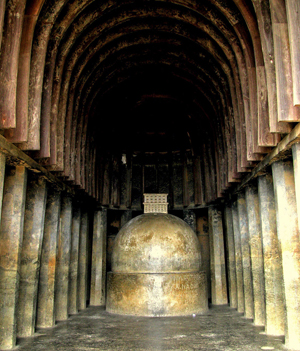
Karla Caves
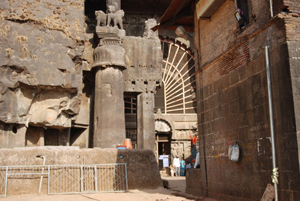
Dating back to the 2nd Century BC, the monuments at Karia are at a distance of II km from Lonavala and just off the Mumbai-Pune road. Themagnificent Chaitya hall at Karia is the largest (124ft x 46.5ft x 45ft) and most evolved example of its class. Three important features of the interior of the hall are columns or pillars, the roof vault andthe great sun windows.
There are 37 columns in all, of which 30 have interesting capitals showing
prosperous men and women riding elephants and horses yet bowingin humility to the Great Buddha. The vaulted roof has wooden supports. This is the only place in India where 2000 year old wood work can be seen. At the far end of the ball-stands a stupa, above which is held an umbrella, a symbol of royalty. The whole system of lighting depends on the enormous sun windows through which cleverly diffused light with its light and shadows gives a great sense of solemnity.




